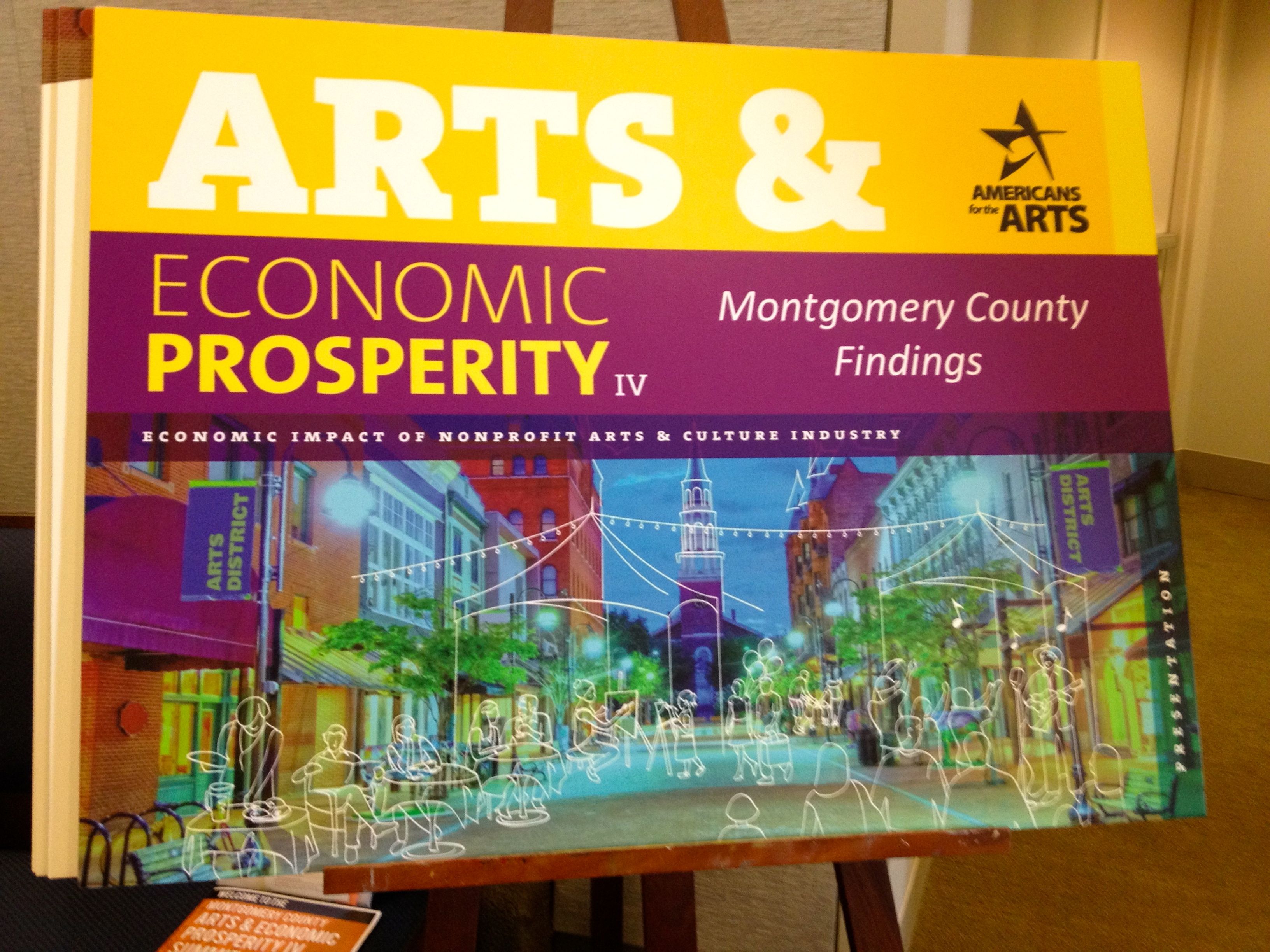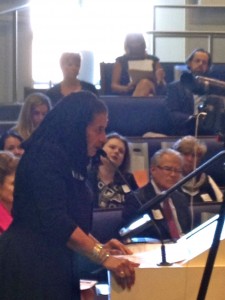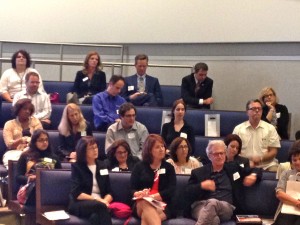
The Arts Generate Millions in Montgomery County
On Sept. 19, the Arts and Humanities Council of Montgomery County released the Arts and Economic Prosperity IV Study at a summit held at United Therapeutics Corporation in Silver Spring.
Nonprofit arts and culture industry generates $151 million in annual economic activity in Montgomery County (AHCMC)—supporting 2,955 full-time equivalent jobs and generating $10.2 million in state and local government revenue—according to the Arts & Economic Prosperity IV (AEPIV) economic impact study.
AEPIV, conducted by Americans for the Arts, is the most comprehensive study of the nonprofit arts and culture industry ever conducted. The study documents the economic impact of the nonprofit arts and culture industry in 182 communities and regions in the United States.
In Montgomery County, AEPIV was coordinated by the Arts and Humanities Council of Montgomery County. Seventy-three county nonprofits participated in the study and 930 valid and usable audience-intercept surveys were collected from attendees at nonprofit arts and culture.
During opening remarks at the summit, Montgomery County Executive Ike Leggett noted, “arts are good business.”
National and Local Context
Nationally, the Arts & Economic Prosperity IV study reveals that the nonprofit arts industry produced $135.2 billion in economic activity during 2010. This spending—$61.1 billion by nonprofit arts and culture organizations plus an additional $74.1 billion by their audiences—supported 4.1 million full-time equivalent jobs and generated $22.3 billion in federal, state and local tax revenues.
Locally, Montgomery County outranks all other jurisdictions in the Greater Washington region with the exception of the District of Columbia in the total economic impact of the arts and culture, jobs, state and local government revenue, and attendance at cultural events.
The Montgomery County study reports that nonprofit arts and culture organizations spent $76.7 million on everything from paper clips to paint to light bulbs during fiscal year 2010. This spending is far-reaching: organizations pay employees, purchase supplies, contract for services and acquire assets within their community. Those dollars, in turn, generated $63.4 million in household income for local residents and $10.2 million in local and state government revenues.
Arts & Cultural Industry Creates Jobs
In Montgomery County, the arts and humanities industry creates 3,000 FTE jobs—and not just arts jobs. The arts and culture sector creates jobs for accountants, carpenters, electricians and maintenance workers, too. “More than most businesses, nonprofit arts and humanities organizations are rooted in their home area,” says AHCMC CEO Suzan Jenkins. “They operate as a small business, employing people locally in jobs that cannot be shipped overseas.” In addition to FTE jobs, 11,642 volunteers put in 520,755 hours of work. According to the Independent Sector[i], this equates to an astonishing $11 million in donated labor.
Arts & Cultural Industry Boon for Local Businesses
Dinner and a show go hand-in-hand. In addition to spending by organizations, the nonprofit arts and culture industry leverages $74 million in event-related spending by its audiences. Attendance at cultural events generates income for local businesses—restaurants, parking garages, hotels, and retail stores. An average arts attendee in Montgomery County spends $21.62 per event over and above the cost of their ticket. On the local level, these audiences provided valuable revenue for local merchants. Here’s a breakdown of 2010 event-related spending in Montgomery County, MD:
· Over $45.4 million on restaurant meals and snacks
· Over $3.5 million on souvenirs and gifts
· Over $2 million on retail (clothing and accessories)
· Over $16.2 million on overnight lodging
· Over $4.9 million on local ground transportation
Montgomery County’s arts and culture community is a great partner for local businesses, offering everything from rental opportunities at unique facilities such as The Music Center at Strathmore, BlackRock Center for the Arts and Glen Echo Park, to joint promotions and customized services for clients. Here’s just a sample of what’s possible: the Marriott Courtyard Silver Spring North receives a weekly email of fun cultural events that is directly uploaded to their daily Go-board in the hotel lobby. Customers love the opportunity to checkout local events and personalize their stay in Silver Spring. Marriott has access to this information through a marketing partnership with DOandGO.org, the County’s online cultural calendar, managed by the Arts and Humanities Council. This relationship gives Marriott a competitive edge in their market.
Impact of Cultural Tourism
Tourism industry research consistently shows that cultural tourists stay longer and spend more than the average traveler. In Montgomery County, in fact, cultural tourists’ event-related spending is more than twice that of their local counterparts: $30.14 vs. $15.51.
“Annually, nearly 2.8 million overnight and 4 million daytrip visitors come to Montgomery County,” says Kelly Groff, Executive Director for the Conference and Visitors Bureau (CVB) of Montgomery County. “Arts and culture are important amenities that business and leisure travelers consider when planning a visit. At the CVB, we take great pride in all the arts organizations, historic sites and performance venues available to our local residents and out-of-town visitors. Tourism research shows that cultural tourists stay longer and spend more money in our community. Cultural tourists multiply their impact by adding on spending in restaurants, parking garages, hotels, and retail stores. Maintaining and growing a robust tourism industry is important to our County and the cultural community is one of the best assets the CVB has when promoting the County as a destination of choice for individual and group travelers.”
A Case for Arts & Culture As Big Business
“Arts & Economic Prosperity IV™ demonstrates that nonprofit arts and culture organizations are valuable contributors to the business community,” says Robert L. Lynch, president and CEO of Americans for the Arts. “They are employers, producers, consumers and key promoters of their cities and regions, and they leverage significant event-related spending by their audiences for local merchants. This study makes it clear that the nonprofit arts and culture industry are not only drivers of business but also a key component to economic sustainability and future prosperity.”
The AEPIV study was conducted by Americans for the Arts and supported by The Ruth Lilly Fund of Americans for the Arts. Americans for the Arts’ local, regional, and statewide project partners contributed both time and financial support to the study. The full text of the national statistical report is available at www.AmericansForTheArts.org/EconomicImpact. For information about the Montgomery County study and a list of participating arts and cultural organizations go to: http://creativemoco.com/aep4.
This is the third cycle of the national Arts & Economic Prosperity study in which Montgomery County has participated. In 2005, the study revealed that nonprofit arts and humanities were a $117 million industry in Montgomery County, generating $7.6 million in state and local government revenue and supporting 2,180 full-time jobs. Additionally, arts and cultural organizations spent $51.6 million a year on everything from paper clips and cans of paint to employee salaries, contracts for services, supplies and more. Spending by cultural patrons packed a punch too, with audiences spending another $65 million in event-related expenses, including over $27 million on restaurant meals and snacks. Local patrons spent approximately $23 over the cost of their event ticket, while non-residents spend about $82. This spending generated revenue for local businesses such as restaurants, parking garages, hotels and retail stores. The 2005 study estimated attendance at cultural events in Montgomery County to be 1.9 million.
The Arts and Humanities Council of Montgomery County (AHCMC) is the County’s designated local arts agency. Through our programs and services, AHCMC provides the infrastructure and support necessary to maintain a robust creative community that includes over 450 cultural organizations and 1500 artists and scholars. AHCMC disburses arts and humanities grant funds, supports the creative community, and provides policy guidance related to the arts and humanities. Above all, AHCMC Connects Community 2Culture.
For more info: www.creativemoco.com.
To view a video about the Arts and Humanities Summit held September 19, 2012, see Arts Mean Business (Video)



Engage us on Facebook
Follow us on Twitter
Tweets by @mymcmedia